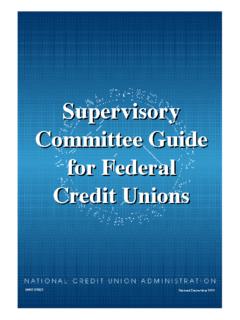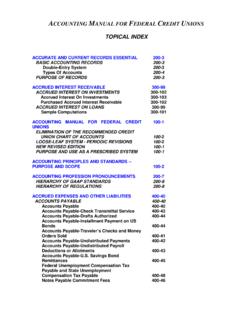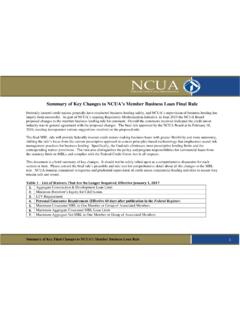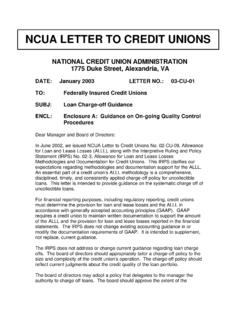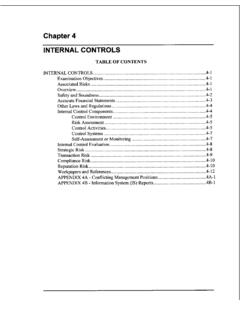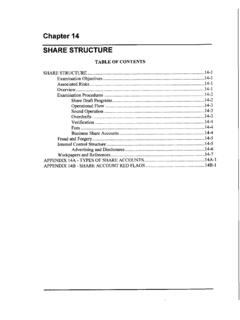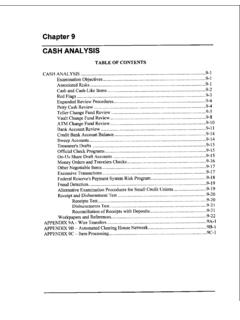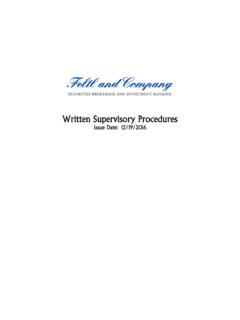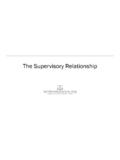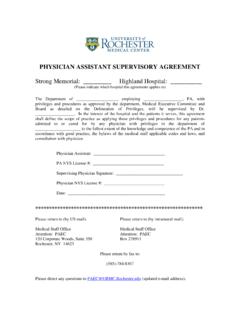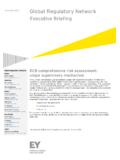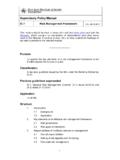Transcription of Chapter 5 SUPERVISORY COMMITTEE - NCUA …
1 Chapter 5 SUPERVISORY COMMITTEE TABLE OF CONTENTS SUPERVISORY COMMITTEE .. 5-1 Examination Objectives .. 5-1 Associated Risks .. 5-1 Overview .. 5. 1 Scope Development and Planning .. 5-2 Meeting with the Internal Auditor .. Reviewing the Annual SUPERVISORY COMMITTEE Audit .. Reviewing the Engagement Letter .. 5-5 Finding an Audit or Verification Unacceptable .. Meeting with the SUPERVISORY COMMITTEE .. Meeting with the External Auditor and Review of Working Papers .. 5-3 If Compensated Auditor's Audit Appears Lacking .. Reviewing the Internal Audit Department .. Internal Audit Program Adequacy .. Internal Audit Review .. 5. 10 Verifications .. 5. 10 Working Paper Access .. 5.
2 10 Signing Waiver Document to Gain Working Paper Access .. 5-11 Supervised Access .. 5. 11 Denial of Access .. 5. 12 Addressing Deficiencies with the SUPERVISORY COMMITTEE .. 5. 12 Mandatory Auditor Rotation .. 5. 12 Other COMMITTEE Duties .. 5-13 Working Papers and References .. 5. 13 APPENDIX 5A . OPINION AUDITS .. 5A-1 APPENDIX 5B . EXAMINATION OF INTERNAL CONTROL OVER CALL REPORTING BY CPA .. 5B-1 APPENDIX 5C . AGREED UPON PROCEDURES ENGAGEMENTS .. 5C-1 APPENDIX 5D . NON OPINION AUDITS .. 5D-1 Chapter 5 SUPERVISORY COMMITTEE Examination 0 Determine the necessary supervision and examination scope based 0 bjectives on the review of the SUPERVISORY COMMITTEE audit, internal audit reports and risk management reports Determine whether the SUPERVISORY COMMITTEE audit and verification meets the requirements of $7 15 and $74 of the NCUA Rules and Regulations Determine if the SUPERVISORY COMMITTEE performs other duties to meet their fiduciary responsibility Determine the advisability of other audits ( , e-commerce, internal control, Statement of Auditing Standard (SAS) No.)
3 70, etc.) 0 0 0 Associated Risks 0 Compliance risk - Includes the risk that the audit and verification does not comply with the laws and regulations; Reputation risk - Includes the risk that the SUPERVISORY COMMITTEE did not meet its fiduciary duties, resulting in poor publicity or administrative action; Strategic risk - Includes the risk that management fails to act on recommendations included in examinations or internallexternal audits, or did not allocate the necessary resources to implement proper internal controls; and Transaction risk - Includes the risk that internal controls do not sufficiently deter or detect errors, omissions or material misstatements. 0 0 0 Overview Reviewing the SUPERVISORY COMMITTEE audit is a required and important aspect of the annual examination.
4 The quality of the audit helps examiners determine the depth of their review. A quality audit can lead to examiner confidence in the records and thereby limit the extent of review. Conversely, a poor audit may necessitate expanding the examination scope. The examiner should ensure that persons performing the audit and verification functions performed them in accordance with $7 15 of Page 5-1 EXAMINER'S GUIDE NCUA 's Rules and Regulations. The examiner's review and evaluation of these functions serve as key elements in determining the examination's scope. Examiners will complete the required questionnaire, SC- Pre-Examination SUPERVISORY COMMITTEE Audit And Verification Review. Additionally, examiners may also complete the following optional questionnaires depending on the type of audit performed: 0 0 SC-Financial Statement Audit by CPA (described in Appendix A); SC-Balance Sheet Only Audit by CPA (described in Appendix A); SC-Examination of Internal Control over Call Reporting by CPA (described in Appendix B); and, SC- Non-Opinion (described in Appendix C or D).
5 Scope Development and Planning The following documents can provide guidance for the examiner during the scope development and planning phase: 0 The annual audit report; 0 Engagement Letter; 0 0 0 0 Any report of reportable conditions or material weaknesses (sometimes referred to as a management letter); Internal audit reports, if any; Risk management or any other applicable audits, if any; Support for the verification of accounts; and Minutes of the SUPERVISORY COMMITTEE meetings; Meeting with the SUPERVISORY SUPERVISORY COMMITTEE to: COMMITTEE The examiner may arrange a meeting with the chairman of the 0 Explain the examiner's mission in reviewing the audit and verification functions; Discuss the SUPERVISORY COMMITTEE 's role and responsibilities, if necessary ($71 ); Answer any questions the SUPERVISORY COMMITTEE may have; and Determine the extent of the COMMITTEE 's knowledge of the credit union's operations, management, and the status of the credit union's financial condition.
6 0 0 0 Page 5-2 SUPERVISORY COMMITTEE Meeting with the The examiner may arrange a meeting with the internal auditor to: Internal Auditor 0 0 0 0 Evaluate the independence and experience of personnel conducting internal control reviews, adequacy of staff size, appropriateness of audit schedule, and sufficiency of scope; Assess the reliability and effectiveness of any internal control review; Review audit reports, letters reporting material weaknesses or reportable conditions, and management s written response to auditors findings; and Review internal audit working papers. Meeting with the External Auditor and Review Of Working Papers The type of audit and the examiner s familiarity with the external auditor will determine the extent of the meeting and review of the audit working papers.
7 If examiners choose to contact the external auditor, they may find it beneficial to obtain the auditor s risk assessment, their conclusions, and resulting modifications to the audit program, including the following: Auditor memorandums relating to audit planning, preliminary analytical procedures, materiality thresholds, discussions with management, etc; and 0 Working papers related to general risks (client s business and industry; significant changes; materiality; general summary of internal controls; and general assessment of risk) and the auditor s assessment detailing conclusions reached. To clarify the auditor s risk assessment as it relates to the examination scope, the examiner should ask about the following: 0 Significant accounts (higher risk is generally localized in a few account balances); 0 Risk level assessed (low, moderate, high) for inherent, control, detection, and assertions risk for each significant account.
8 Inherent risk plus Control risk = Risk of Material Misstatement (RMM); Page 5-3 EXAMINER S GUIDE 0 Risk factors in place to mitigate risk ( , monitoring by third parties, inquiry or observation of controls, prior audit experience, and procedures performed in understanding and testing controls provide evidential matter); 0 Conclusions and findings of control testing. No assurance = Maximum control risk; and 0 The auditor s assessment of combined risk (RMM) and resulting determination of audit program steps. The examiners understanding of these aspects of the auditor s work may help them plan and determine the examination scope. If examiners decide to review the SUPERVISORY COMMITTEE and its functions, but have not obtained the information discussed above in the planning phase, they should obtain these items early in the fieldwork phase to minimize duplication of effort, when possible.
9 If the examiners cannot rely on the work of the external auditor, they may need the duplication of efforts to properly assess risk areas. Review i n g the Annual SUPERVISORY COMMITTEE NCUA Rules and Regulations $ $ set forth the minimum requirements for a SUPERVISORY COMMITTEE audit and verification consistent with the FCUAct $1 15. SUPERVISORY committees often engage external auditors to assist them in meeting this requirement. The approach the examiner should take in reviewing the audit depends on the type of audit for which the SUPERVISORY COMMITTEE contracted: Audit Financial statement opinion audit (Appendix A); Balance sheet only opinion audit (Appendix A); An examination of internal controls over call reporting (Appendix B); or Other SUPERVISORY COMMITTEE audits such as: - - Non-opinion audits (Appendix D).
10 CPA Agreed-Upon Procedures Audits (Appendix C); and Certain circumstances may prompt the examiner to consider requiring an independent audit performed by a CPA. Refer to $7 1, Sanctions for failure to comply with this part, and $ , Statutory audit Page 5-4 SUPERVISORY COMMITTEE Review i n g the Engagement Letter remedies for Federal Credit Unions, of the NCUA Rules and Regulations. NCUA Rules and Regulations $7 (b), Engagement letter, requires that the SUPERVISORY COMMITTEE obtain an engagement letter when they hire a compensated auditor. Also, $ (c), Contents of the letter, $7 1 (d), Complete scope, and $ $7 1 (e), Exclusions from scope, discuss the minimum requirements for such an engagement letter.

